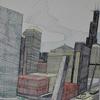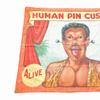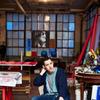$100 Million Redesign of 1.3 Mile Section of L.A.'s Crenshaw Boulevard to Feature Major New Works by 100 Black Artists
- October 14, 2021 10:09
Destination Crenshaw, the $100 million public-private initiative to redesign 1.3 miles of Crenshaw Boulevard as an economically thriving business and cultural corridor for Black L.A., took a major step forward on Thursday, as the Los Angeles Cultural Affairs Commission approved plans for the permanent installation of seven outdoor sculptures along the route. Destination Crenshaw has now unveiled the designs by the seven outstanding artists, all closely connected to the Black community of South Los Angeles, who were chosen as the first to contribute new artistic landmarks to the corridor: Charles Dickson, Melvin Edwards, Maren Hassinger, Artis Lane, Alison Saar, Kehinde Wiley, and Brenna Youngblood.
The works now unveiled are the first of many to follow. One hundred Black artists at all stages of their careers will have works installed along Crenshaw Boulevard, making Destination Crenshaw the largest commissioning initiative ever undertaken for Black artists. Taken together, the works will contribute to a sense of aesthetic permanence for Black Los Angeles. The installations are part of an ambitious reimagining of this major artery of Black L.A., which is being transformed through a comprehensive, Afrocentric streetscape design by Perkins&Will, new green community gathering places designed by Studio-MLA, and cutting-edge augmented reality storytelling by Gallagher & Associates.
Now under construction, Destination Crenshaw is improving infrastructure and building green community gathering places and parks, making direct investments in small businesses along Crenshaw, adding hundreds of trees, and installing works of art that tell the story of Black Los Angeles — past, present, and future. Construction began in 2021 and will be complete in 2022.
Funding from diverse public and private sources now stands at $61.5 million, with the Getty Foundation recently adding to the momentum by committing $3 million in grants. In addition, NBA star DeMar DeRozan of the Chicago Bulls has volunteered his leadership support for the Sankofa Circle fundraising group, which provides high-level naming opportunities at Destination Crenshaw’s Sankofa Park.
Getty’s funding will support the commissioning, fabrication, and installation of works by Los Angeles Black artists and create a larger partnership with Destination Crenshaw. The Getty Conservation Institute will advise on a conservation and maintenance plan of the public artworks. Getty support will include a program of youth internships and apprenticeships, helping to instill a sense of community pride and ownership of the works and creating job opportunities for young people in the Crenshaw neighborhood. Destination Crenshaw will also develop joint public programming around the artworks with Getty, working with the African American Art History Initiative of the Getty Research Institute.
Jason W. Foster, President and Chief Operating Officer of Destination Crenshaw, said, “We’re thrilled by the enthusiastic support the City of Los Angeles has given our plans to strengthen the community by installing these exceptional works, whose artists have been nurtured and inspired by the Crenshaw neighborhood. We express our deep gratitude to the Getty Foundation and all our generous donors for committing themselves to this community-led project, which we initiated with the conviction that residents of one of the world’s largest and most creative Black neighborhoods deserve to live in a beautiful, green, artistically impressive and economically strong environment.”
Joan Weinstein, Director of the Getty Foundation, said, “Destination Crenshaw will be a fitting and joyful tribute to Black creativity and history, combining a high level of artwork, urban design, and landscape design with targeted economic investment and community engagement every step of the way. We are proud to join with other funders, public and private, in supporting this ambitious cultural place-keeping initiative, which though unique in location and scope can serve as a model for other communities throughout the country.”
About the First Installations
Four of the initial seven sculptures, by Charles Dickson, Maren Hassinger, Artis Lane, and Kehinde Wiley, will be installed at Sankofa Park, the northernmost public gathering place that Destination Crenshaw is creating, at 46th Street. The sculpture by Melvin Edwards will be installed approximately halfway along the route, at 54th Street. The works by Alison Saar and Brenna Youngblood will be installed toward the southern end of the route, near Slauson Avenue, in Welcome Park and I AM Park.
Sankofa Park
The traditional African symbol of the sankofa bird, which flies toward the future while curving its neck around to view the past, is reflected in the design of Sankofa Park. There, the sculpture Car Culture, by Charles Dickson, expresses the confluence of spirit, place, and intention in Black life in Los Angeles, where cars rather than the sankofa bird symbolize mobility. Cars are fundamental to Crenshaw’s communal street life, and Car Culture incorporates elements of the cars that might be seen when the low riders gather in Leimert Park. The sculpture’s main body is a trio of elongated figures resembling West African Senufo ritual objects, which are the conduit between the living and spirit worlds. Adapting this idea, Dickson uses fiber optic cables to connect these figures—larger-than-life portals to the past—with their crowns, which are fashioned from the fronts and ends of cars. Atop these car parts rests a fanciful engine, a symbol of our capacity to engineer our futures by sustaining a relationship with the vitality of the past.
Maren Hassinger often works with unconventional materials such as plastic bags, tree limbs, and leaves, inviting viewers to engage with the stories she tells through material and form. Her contribution to Destination Crenshaw, An Object of Curiosity, Radiating Love, is a large pink fiberglass orb, 6 feet in diameter, which glows with a soft pink when viewers approach it. It is the most conceptually abstract of all Destination Crenshaw's permanent commissions, yet it may also be the most accessible because of the visceral impact of its interaction with people, which enables them to feel they are communicating with it. Encountered in Sankofa Park’s communal space, the sculpture is a symbol of the love that members of the community need if they are to be in service to one another, resisting gentrification and erasure.
Artis Lane considers the figure of the Black man to represent universal humanity, which experiences struggles and achievements as it undergoes a transformation into awareness. For the Sankofa Park site, the artist uses her Emerging into Spirit concept to engage with the Crenshaw neighborhood as a site of discovery, communion, opportunity, and growth. Emerging First Man is a larger-than-life bronze figure that bears on its surface the casting materials from the foundry where it was made, symbolizing a physical and spiritual birth into an understanding of purpose and possibility. It is conceived as a beacon of hope, reminding the community that we are all in the act of becoming, with our human experiences moved by divine intentions that enable us to be our best selves.
Kehinde Wiley’s sculpture is of a young, West African woman, rising up from the streets of Crenshaw Boulevard and Leimert Park. She will stand as a corrective, artistic intervention and a code switch. She is positioned like the Sankofa figure, moving forward and embracing the past as a function of a much broader and inclusive worldview to strengthen the ongoing legacy of the neighborhood. This is Wiley’s first large public sculpture featuring a woman on horseback. Wiley empowers her to stand as an indictment of the ways in which African women have traditionally been viewed.
54th Street
Throughout his career, Melvin Edwards has been interested in chain links as a material that can tell stories about connection and community. In works installed throughout the United States, as well as in Cuba, Brazil, and Senegal, he has used chain as a stand-alone element, expressing collective unity, resistance, and the fortitude not only to endure but to thrive. Column, rising to a height of more than 36 feet, is his largest chain work to date. Its surface of burnished stainless steel reflects the community in which it stands and with it the residents’ generative legacy of cooperation and innovation. The verticality of the chain represents how our stories build upon another, how we stand on the shoulders of those who came before us, and how our collective engagement becomes the structure for our own success.
Welcome Park
Alison Saar honors the past, present, and futures of Crenshaw with Bearing Witness, an installation of two 13-foot-tall bronze figures, one female and one male, facing one another at a crossroads of the Boulevard. In a continuation of her use of “Black hair” as a potent visual language, the artist has fashioned the enormous coiffures of the two figures out of everyday objects culled from local thrift stores. Cast in bronze, these objects represent the art, music, and literature that make Crenshaw a destination. Carrying these symbols of the community in their hair, the two figures become an architecture of human labor and innovation and like the poteau-mitans of Haitian vodou are conduits for the spirits to descend and interact with the faithful.
I AM Park
After moving her home and studio to Crenshaw, a neighborhood she visited as a child when she was growing up in Riverside, Brenna Youngblood revisited an existing sculpture, MIA, to express the creativity, vitality, and innovation that grow out of a strong Black community where children have the opportunity to grow into the fullness of themselves. Fashioned to resemble large play blocks or a jungle gym, the sculpture reorders the letters MIA into I AM, asserting one’s own power to name and to know. The concept also recalls the 1968 sanitation workers’ strike in Memphis, the place of Dr. Martin Luther King, Jr.’s last campaign, where protestors marched with placards declaring I AM A MAN: a rallying cry of the Civil Rights struggle and other resistance movements in which people have demanded to be seen as human beings with agency.





















